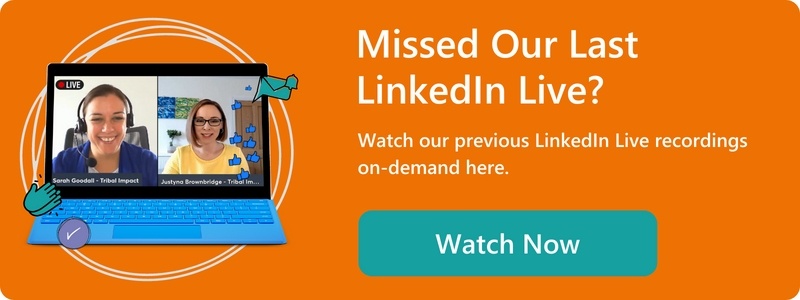Our weekly LinkedIn Lives series focuses on bringing together marketing, sales and HR professionals to discuss their lessons in running employee activation programs on social media.
During one of the recent events, Tribal Impact’s CEO Sarah Goodall, spoke to Malin Liden, Vice President, Head of EMEA Marketing Transformation Office at SAP.
You can watch the full interview here, or check out the summary of what they discussed below.
The connection between employee advocacy and culture
There is a clear connection between the success of your employee advocacy program and the culture within your organisation.
‘Think of employee advocacy as the shop window to your company’s culture,’ said Malin during the LinkedIn Live.
She continued to explain that employee advocacy makes the type of culture a company has very visible. Positive culture will support your employee advocacy by promoting openness as well as embracing the diversity of opinions and voices.
Businesses need to change how they see social media
Many businesses use employees’ social media accounts to push content published from company pages. Followers of those profiles can then end up seeing the same content over and over. This can lead them to becoming disengaged and reduce the reach of posts instead of improving it.
One of the reasons behind this is the desire to control everything employees say on social media. However, this isn’t possible.
Malin described trying to control everything that happens on social media ‘like trying to push a wave back with your hands. It's very difficult. The water goes through your hands. You get very wet, and you’re not going to be successful because we can’t stop a wave of water with your hands. Instead, if you're a clever leader, you turn around and you ride on the wave,’ she continued.
Whether you like it or not, your employees are on social media. Many of them are actively discussing various subjects and you can’t stop it. Instead, Malin recommends investing in positive culture and teaching employees how to use social media properly.
Successful employee advocacy requires an open culture
If the culture within your organisation is very controlling, it will be more difficult to activate your employees online, especially if you try to push them to be active.
They will inevitably make mistakes. But, the positives outweighed the negatives: ‘The positive side on the balance sheet is much bigger than the negative one. So even if you have a little bit of damage here and there, then the positive effect will be so much bigger if you embrace it’.
When you embrace it, you ‘have a culture of empowerment, because employee advocacy done right takes a little bit of courage. You have to allow the diversity of voices you have and allow things that are maybe not polished the way you would have polished it.’
This can make businesses uncomfortable, but ‘all of it coming together is really giving colour to your company’s or your organisation's story’.
Employees need to understand what social media can do for them
It’s also important for employees to understand how social media can benefit them.
Instead of forcing your staff to use social media, or using their bonus or even their job as a motivation to use it – which can lead to a negative culture – come up with ways for them to find joy and reward in using it. ‘If people enjoy what they’re doing, they’ll do it again and they’ll do it much better,’ said Malin.
That is why it is important to empower people to dare to start being active at least once and to support them with various tools, coaching and culture to maximise their chances of being successful.
When employees experience success, whether that’s in terms of comments, new connections, or something else, they’re going to find it more rewarding then just sharing a branded post that gets ignored. They’ll then be more likely to do it again.
Conclusion
Employee advocacy can’t fix culture, but it does reflect it. Businesses, therefore, need to consider the existing company culture and if it’s compatible with employee advocacy, or if steps need to be taken to adjust to a more open, empowering one first.
In an open culture, employees will feel more able to post their business and industry-related opinions on social media without fearing for their jobs. Instead, they’ll focus on the positives and how social media can help them grow their career.
To find out what other great tips Malin had for change management, culture, and employee advocacy, watch the replay here.


